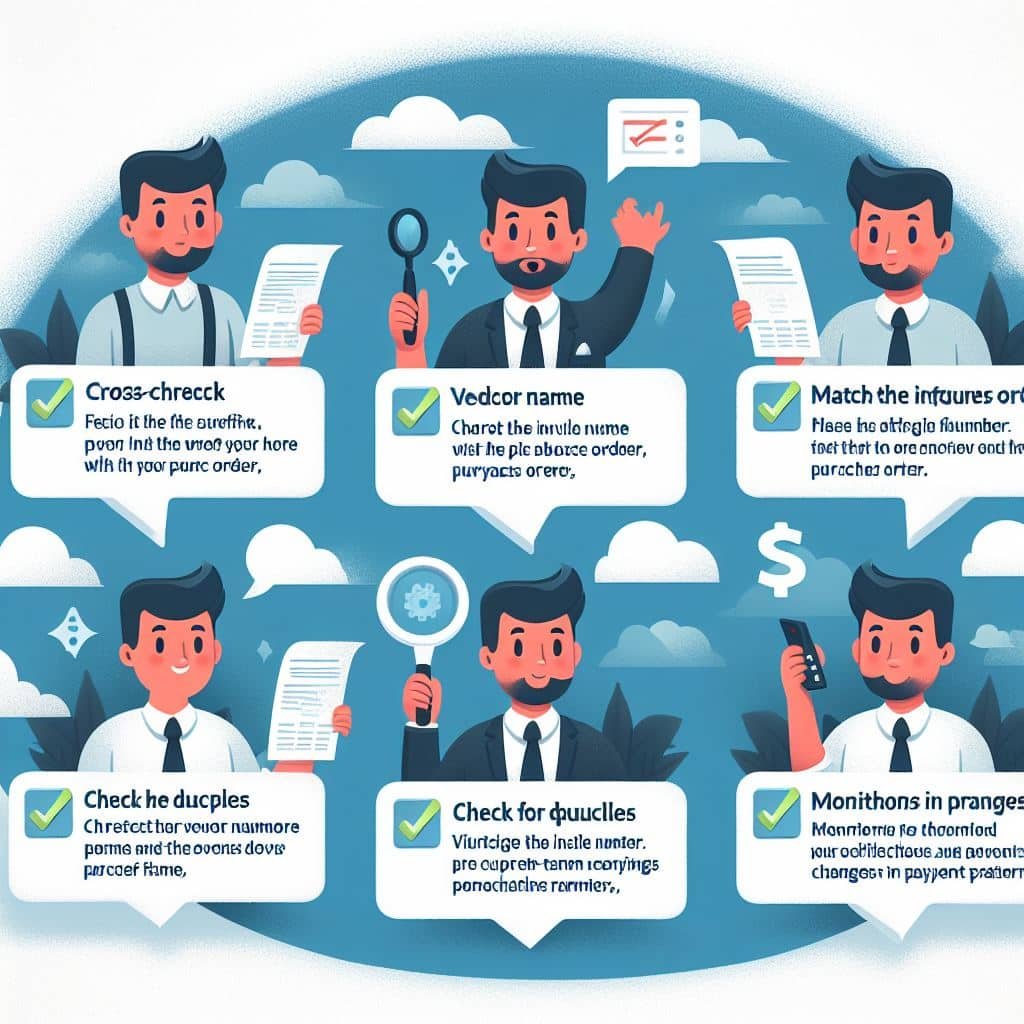Invoice fraud is a scam in which companies or individuals submit fake, modified, duplicated, or misleading invoices for payment for products or services that were never ordered, delivered, or properly rendered. According to estimates from the Association of Certified Fraud Examiners (ACFE), organizations lose over 5% of annual revenues to fraud every year. Learning how to properly spot and avoid invoice fraud is critical for protecting any business.
Detecting fraudulent invoices requires awareness of common scams as well as vigilance in verifying order details, deliveries, vendor legitimacy, and inspecting all documentation for accuracy or suspicious signs. Prevention requires implementing strong approval procedures, enhancing vendor authentication protocols, providing staff training, setting up automated invoice verification and monitoring, and continuously updating countermeasures.
Recognizing Potential Invoice Fraud

Many types of invoice fraud manifest in distinct ways:
- Fake invoices for non-existent work or goods
- Duplicate invoices already paid previously
- Inflated invoices exaggerating quantities or costs
- Modified invoices with altered payment details
Always scrutinize invoices thoroughly before paying and be alert for any unusual changes, inaccuracies, or duplicate submissions.
Six Ways to Detect Possible Invoice Fraud

- Verify vendor legitimacy: Search company names, addresses, and contact details to ensure the business exists and matches previous records. Be wary of sudden vendor changes. Require updated W9 forms.
- Look for unusual changes: Significant changes in style, format, details, bank accounts, contact info, or addresses may indicate fraud.
- Check for duplicate invoices: Require invoice numbers and match to previous submissions. Use automated duplicate checking tools to catch copies or reruns.
- Examine details closely: Check that descriptions, quantities, rates, calculations, and totals make sense against what was ordered and previously billed for accuracy.
- Confirm delivery of goods/services: Verify correct items and quantities were physically received before paying. Beware ghost shipments.
- Trust instincts if something seems suspicious: Small odd details or “gut feelings” that an invoice looks fraudulent warrant further verification and could prevent major losses down the road. Don’t ignore concerns.
Document any irregularities found and proceed to reporting procedures. Gather as much proof as possible.
Preventing Invoice Fraud
Alongside detection, businesses must implement prevention best practices to mitigate invoice fraud risks including:
1. Approval Procedures
Create approval rules for purchasing and payments by designated managers above certain thresholds. Require secondary authorization for large invoices or unusual cases. Institute least-privilege policies so no single employee can issue/approve their own purchasing.
2. Staff Fraud Training
Educate employees involved with orders and payments on spotting risk factors and fraudulent techniques to foster responsibility and vigilance.
3. Enhance Invoice Verification
Add steps to confirm order accuracy and delivery prior to approval. Automate duplicate invoice detection. Require manual secondary reviews above certain totals.
4. Strengthen Vendor Authentication
Introduce new vendors via signed purchase orders. Perform background checks on new vendors. Enforce annual updated W9 forms to ensure recipient details haven’t changed without awareness.
5. Set Up Fraud Alerts
Use data analytics software to automatically flag unusual spikes in payments, duplicates, or changes in vendor details for follow-up reviews.
Regularly updating measures is vital as criminals craft ever-more sophisticated scams. Ongoing prevention reduces opportunities dramatically.
Responding to Suspected Invoice Fraud
Despite best efforts, some fake, duplicate, or misleading invoices may slip through and require an immediate, coordinated response including:
1. Gather Documentation
Gather invoices, bank details, related contracts, delivery receipts, purchase orders, and statement history to aid any fraud investigation. Preserve electronic copies and physical originals without alterations.
2. Report Issues Internally
Alert management and finance departments per internal controls procedures about suspected fraud. Detail circumstances with collected documentation. Get guidance on next actions.
3. Contact Vendors
Discuss issues directly with vendors involved to determine if an innocent error occurred which they can reconcile or provide context on. Cease any ongoing work under suspicious situations.
4. Involve Auditors
If substantial invoice fraud seems evident, engage auditors to formally investigate scale, associated losses, and control gaps exploited for improvements. Auditors preserve forensic evidence properly for potential legal actions.
5. Notify Authorities
Report major fraud beyond simple reconciliation to authorities. Provide all documentation gathered during investigation on fraudulent activities. Support their investigation and any resulting prosecutions.
Though rare with vigilant prevention, occasional invoice fraud still occurs. Handling issues swiftly, seriously, and cooperatively limits disruptions and further losses.
Recovering from Invoice Fraud Events
If impacted by a major invoice fraud scheme, focus on navigating the aftermath for financial recovery by:
- Improving fraud controls: Analyze gaps that failed to prevent issues and implement stronger approval rules, duplicate checking, and internal audits. Continue staff training.
- Seeking reimbursement: Depending on coverage amounts and limitations, file claims against employee theft insurance or fidelity bonds covering losses from non-collusive fraud by workers.
- Disputing with vendors or lawsuits: Consult lawyers regarding voiding liability for fraudulent invoices potentially tied to vendor collusion, then either directly dispute with vendors demanding repayment or file civil lawsuits to seek rulings ordering restitution. Lawsuits show willingness to prosecute fraud vigorously.
- Tax write-offs: If unable to fully recover direct losses from fraud, declare these on taxes as theft losses according to IRS rules which allow deductions against income.
No single technique recovers fully from fraud events. Pursuing multiple strategies in parallel ensures the best financial outcome if unfortunately victimized by invoice scams.
Ongoing Prevention
Invoice fraud demands small businesses remain continually vigilant against evolving techniques:
- Update protocols regularly: As new risks appear, refresh policies, require more employee training, and add protective measures to address emerging fraud vectors.
- Conduct audits and testing: Perform regular internal spot audits, automated monitoring, and test expenditures against fraud standards to uncover control gaps or suspicious activity for improvement.
- Communicate with vendors: Maintain positive transparent relationships with regular vendors and keep contact details current through twice yearly reconciliations, encouraging reports of any payment issues noticed.
- Monitor emerging scams: Study fraud alert publications tracking criminal innovations and use these insights to enhance business practices, training, and data analytics countermeasures.
Fraudsters endlessly seek new ways to bypass defenses emphasizing why constant enhancement of preventative measures pays dividends reducing future potential disruptions or losses.
Conclusion
Invoice fraud represents a prevalent risk demanding extensive prevention protections backed by detection best practices via staff awareness training, strict verification procedures, segregated duties, duplicate invoice automation, data analytics, and maintaining thoughtful vendor relationships. Handling occasional incidents firmly limits potential impacts while driving cultural responsibility surrounding payments and orders. With comprehensive resilient measures continually updated, companies gain assurance against varied invoice fraud schemes helping to efficiently avoid these complex troublesome crimes.
FAQs
What are some common types of invoice fraud?
Some of the most common invoice scams include billing for work that was never done, submitting inflated invoices that exaggerate prices or quantities, duplicating invoices for payments already made, and modifying legitimate invoices by altering things like bank account numbers or contact information.
How can I verify an invoice is legitimate?
To determine if an invoice is legitimate, thoroughly validate details like descriptions, quantities, rates, calculations, vendor contact info, and bank accounts against previous records. Check that ordered items were physically received against packing slips. Review for unusual changes in style, format, or vendor details. Finally, directly contact the supplier if any suspicion exists.
What tools can help prevent invoice fraud?
Automating duplicate invoice detection, instituting secondary approval requirements for large invoices, performing background checks on new vendors, requiring periodic W-9 refresh forms from suppliers, and setting up data analytics-driven fraud alert systems can all help prevent invoice scams.
What should I do if I discover an instance of invoice fraud?
If you uncover a fraudulent invoice, gather as much documentation related to the order and transaction as possible. Report the incident internally to management and finance leaders per policy. Contact the vendor involved directly with your concerns and evidence. Engage professional auditors for large, complex cases. Also notify relevant authorities so formal investigations can commence.
How can my business recover financially from invoice fraud?
Pursue insurance reimbursements for covered losses, pressure vendors to repay illicitly gained funds, or initiate civil lawsuits seeking court rulings forcing restitution. Tax filings also allow declaring uncovered portions of loss due to theft as deductions in certain circumstances according to IRS regulations and rules.
Why must I invest continually in updating defenses against invoice fraud?
Sophisticated criminals constantly develop new invoice scam techniques requiring ongoing enhancement of prevention protocols to address emerging threats. Regular refreshing of policies, staff training, fraud pattern analytics, and internal controls ensures continued resilience against complex evolving fraudsters.
